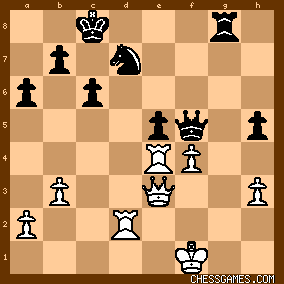| KEG: As in his game against Lasker in Round 10, Janowski here in Round 20 once again played his 3...a6 line against Pillsbury's Queen's Gambit and, after 4. cxd5 exd5 5. Qb3, again played the poor line with 5...c6 (5...Nc6 would have been better) and 6...Bd6 (losing time with the Bishop which ultimately had to retreat to e7). Then, after Pillsbury--like Lasker--played 7. Bg5 (7. e4 was much stronger) Janowski varied from his 7...Be7 against Lasker with 7...Nf6 and--as BipolarFanatic noted over ten years ago on this site--got a bad position from which he suffered for most of the game. Pillsbury should perhaps have played 10. BxN instead of 10. NxN+ and 11. BxN instead of 11. Qe3+, but his actual line certainly yielded him a big advantage in space and initiative. After 19...Rae8, the position was as follows:

click for larger viewOpinion is apparently divided concerning who had the better game at this point. According to the Tournament Book, Pillsbury "was of [the] opinion that White has the advantage." The Tournament Book, however, cites White's isolated Queen's pawn and says that it "does not dislike Pillsbury's position." Fritz rates the game as (0.85) in favor of White here, and I suspect most attacking players would want to be White here. Despite the isolated pawn, White has all the play, as Pillsbury went on to demonstrate. Note that had Janowski played 19...Qxa2 instead of 19...Rae8 Pillsbury would have blown him away after 20. Nh4. Whatever the evaluation of the diagrammed position, there can be little doubt that after Janowski's weak 22...Qh5 Pillsbury had a substantial if not winning advantage. Faced with this tough position, Janowski began a remarkable march of his King from g8 all the way to c8. At first blush this looks zany, but closer analysis reveals that Janowski's plan was a good one. According to Sergeant in his book on Pillsbury's career, Pillsbury got into time trouble attempting to find a way to exploit Janowski's creative defensive maneuvering, and after Janowski's very strong 28...e5, the game was nearly equal. But Pillsbury continued to press Janowski, and after his 36. Nf5 reached the following position: 
click for larger viewJanowski here sacrificed the exchange with 36...RxN. The Tournament Book calls this move "forced," and Sergeant notes that such efforts as 36...Rh7 would have been crushed by Pillsbury with 37. Rd6 Qf7 38. Rxc6+! Fritz agrees and gives Janowski's move as best. Pillsbury had the better chances after the exchange sacrifice, but Janowski definitely had counter-play. After Pillsbury's questionable 38. f4 (38. Ke2 was much better), the critical moment of the game had arrived, and Janowski pondered his response for forty minutes according to the Tournament Book: 
click for larger viewHere Janowski, after his long think, played 38...h4 instead of the better 38...exf4. The Tournament Book claims that 38...h4 loses the game while 38...exf4 would have given Janowski winning chances or a draw at worst. This is all wrong. While 38...h4 was indeed best in the diagrammed position, Pillsbury would still have had an advantage, and Janowski was most definitely NOT lost after 38...exf4. In fact, Janowski's losing move was 39...Rf8. Had he played 39...Rd8, a move neither the Tournament Book nor Sergeant mentions, his attacking chances would have been far better and he could have avoided defeat. After 39...Rf8, Pillsbury's brilliantly blasted Janowski away. The game was prolonged to 72 moves only because Janowski decided to play on. If he was wondering whether Pillsbury had the technique to win this won position, he got his answer! | 




